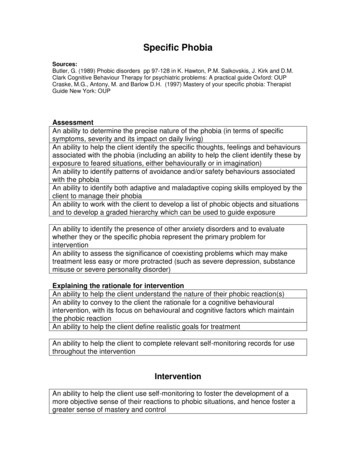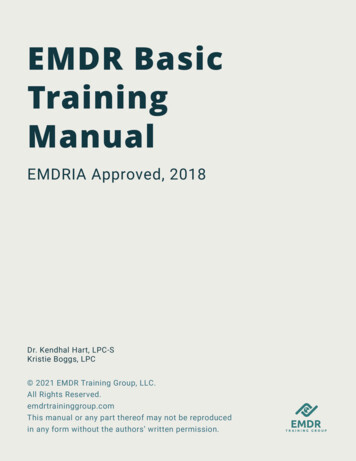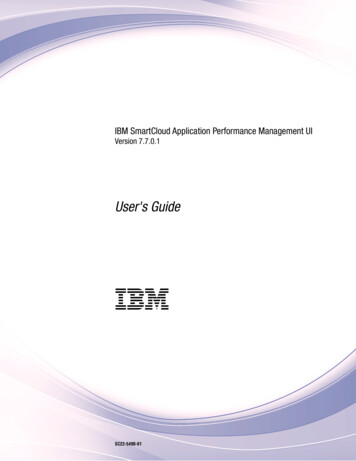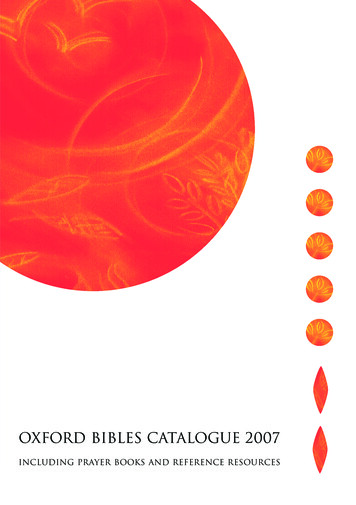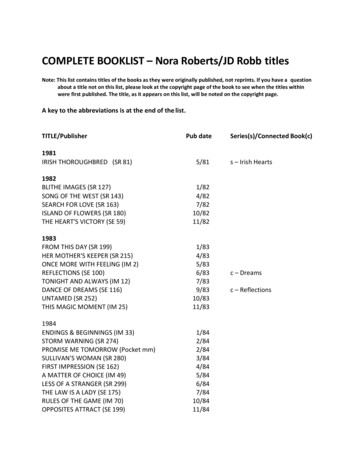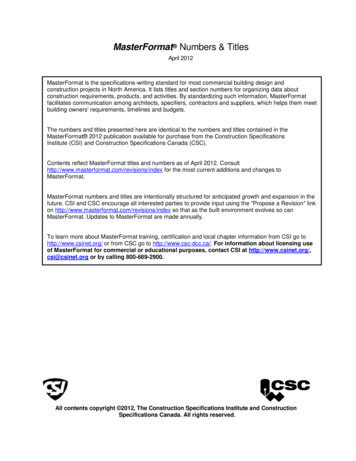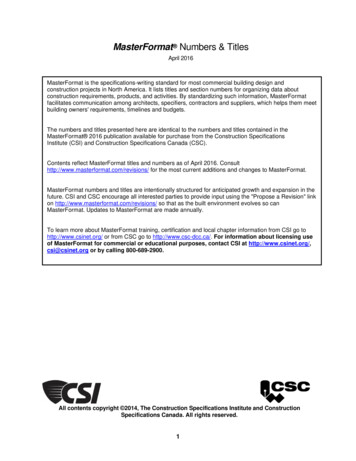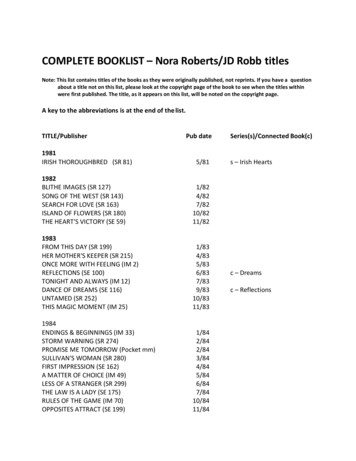
Transcription
1New Titles CatalogueAcademic, Professional, and General PublishingOxford University PressJanuary – March 2014NTC 2014 cover.indd 101/11/2013 13:45
highlights from oxfordThe Improbable PrimateHow Water Shaped Human EvolutionClive Finlayson 16.99See page 5Ancient SyriaA Three Thousand Year HistoryTrevor Bryce 25.00See page 17WRONG: Nine Economic PolicyDisasters and What We Can LearnFrom ThemRichard S. Grossman 18.99See page 22NTC 2014 cover.indd 2Teeth:A Very Short IntroductionPeter Ungar 7.99See page 6Classical LiteratureA Very Short IntroductionWilliam Allan 7.99See page 17Does Capitalism Have a Future?Georgi Derluguian 14.99See page 22Atkins’ Physical ChemistryPeter Atkins 49.99See page 16CybersecurityWhat Everyone Needs to KnowPeter Singer 48.99See page 21The Oxford Handbook ofthe Economics of GamblingLeighton Vaughan Williams 100.00See page 2401/11/2013 13:45
highlights from oxfordBy All Means NecessaryElizabeth C. Economy 18.99The History of OxfordUniversity PressThree Volume SetIan Gadd 250.00See page 31RebellionBritain’s First Stuart KingsTim Harris 30.00See page 33See page 29The EU Law of CompetitionFaull and Nikpay 245.00See page 59A Will to BelieveShakespeare and ReligionDavid Scott Kastan 25.00See page 62NTC 2014 cover.indd 3The Compleat AnglerIzaak Walton and Charles Cotton 14.99See page 63Oxford Handbook ofClinical MedicineMurray Longmore 29.99See page 75MoneyÉmile Zola 9.99See page 63Tweeting to PowerJason Gainous 16.99See page 10501/11/2013 13:45
contentsarchaeology2arts & architecture3biography4biological sciences4business & management9chemistry14classical studies & ancient history16computing sciences21economics & finance22Trade orders and enquiries from the UK, Europe, the Middle East,Latin America, and the Caribbean should be sent to:geography29Oxford University Press Distribution Services, Oxford UniversityPress, North Kettering Business Park, Hipwell Road, Kettering,Northamptonshire, NN14 1UA, UK.history30language & e & health69music82philosophy88HOW TO ORDERTrade CustomersTel: 44 (0) 44 (0)1536 452640Email (orders): trade.orders.uk@oup.comEmail (enquiries): bookquery.uk@oup.comElectronic ordering services including EDI and PubEasy are alsoavailable for UK and European retail trade customers – for furtherinformation see www.oup.com/uk/help/orderingTrade customers in other areas should send orders and enquires totheir local Oxford University Press Branch or Agent. Please see thelist at the back of this catalogue.Further resources for trade customers – including information ontrading with OUP, bestseller order forms, access to jacket images,and a catalogue order form – can be found on our booksellerinformation pages at ics102Ordering online – customers in many countries can order usingcredit or debit cards at www.oup.com/ukpsychology & neuroscience111Ordering by phone – please call our customer service team on 44 (0) 1536 452640*reference116religion & bibles119Please order through your usual library supplier, or direct fromOUP on 44 (0) 1536 452640*Individual CustomersOrdering from local retailers – Oxford books and other productsare available through most good bookshops. If a title is notavailable on the shelf your local bookshop should be happy toorder it on your behalf.society, culture, & environment127* Our customer service teams are available from Monday-Friday,08.30 am – 17.00 pm, UK time. Telephone calls may be recordedfor training purposes.index130 Orders on account only – please do not send payment carddetails by email or fax as this is not a secure method.branches1551Jan-Mar 2014 Catalogue.indd 107/11/2013 11:39
archaeologyACADEMIC & PROFESSIONALThe Oxford Handbook of MaritimeArchaeologyEdited by Alexis Catsambis, Naval History andHeritage Command, Edited by Ben Ford, IndianaUniversity of Pennsylvania, and Edited by Donny L.Hamilton, Texas A&M University A past presidentof the Instituteof NauticalArchaeology, DonnyL. Hamilton is aleading figure andpioneer in the field Will appeal toprofessionalarchaeologists aswell as the divingcommunity Comprehensive survey ofthe field International perspectivesand a global approachNEW INPAPERBACKThe Oxford Handbook of Maritime Archaeology is acomprehensive survey of the field at a time whenmaritime archaeology has established itself as amature branch of archaeology. This volume drawson the expertise of nearly fifty international scholarswho examine the many distinct and universalaspects of the discipline.Readership: Students and scholars of archeologyand maritime historyOxford Handbooks(OUP USA)February 2014 42.50, AJ, 978-0-19-933600-5, Paperback, 1240pp.226 illus.BIC: Archaeology, AnthropologyLucy to LanguageAn Archaeology of the TroublesThe Benchmark PapersThe Dark Heritage of Long Kesh / MazeprisonEdited by R. I. M. Dunbar, University of Oxford,Clive Gamble, University of Southampton, andJ. A. J. Gowlett, University of LiverpoolLaura McAtackney, University College Dublin Only independent archaeological study of anow demolished site Brings together diverse sources that either nolonger exist or are highly inaccessible A material based approach to exploring theTroubles and peace process Contains major review papers on humanevolution Encompasses the output of a major 7-yearprogramme grant from the British Academy Uniquely multidisciplinary Discusses new ideas about human cognitiveand social evolution Overtly engages with the political context of thearchaeological investigation Illustrated throughout Illustrated throughoutThe concept of the social brain has become apopular topic and contributed to a wide publicexamination of human culture, nature, mind, andinstinct, as well as aspects of social and businessorganisation. At its core, the hypothesis that oursocial life drove the dramatic enlargement of ourbrain, bridges the dimensions of our evolutionaryhistory and our contemporary experience. This hasbeen the focus of a seven-year research projectfunded by the British Academy, the British AcademyCentenary Research Project (otherwise known asthe Lucy Project). The main aim of the Lucy Projecthas been to explore these two axes in an integratedset of studies whose focus was to link archaeologyand, in its broadest sense, evolutionary psychology,which offers powerful, new explanatory insights.In this volume of published an unpublished papers,the contributors explore the question of just whatit is that makes us so different, and why and whenthese uniquely human capacities evolved.Readership: For students and scholars interestedin archaeology, palaeontology, evolutionary studies,sociology, psychology, and anthropology.February 2014 95.00, AJ, 978-0-19-965259-4, Hardback, 544pp.59 in-text illustrationsBIC: Archaeological theory, Archaeological science,methodology & techniquesLong Kesh / Maze prison was infamously the majorholding centre for paramilitary prisoners during thecourse of the Troubles in Northern Ireland. Over adecade after the signing of the Belfast Agreement(1998), Long Kesh / Maze remains one of the mostcontentious remnants of the conflict and hasbecome central to debates about what we do withsuch sites, what they mean, and how they relate tocontemporary rememberings of the difficult recentpast.The only independent archaeological investigationof Long Kesh / Maze prior to its partial demolition,this volume reveals the seminal role of materialculture in understanding the prison continuing intothe peace process. It moves from traditional uses ofsolely documentary and oral evidence to exploringthe full range of material remains of the prisonas they have been abandoned in situ or beendispersed and re-contextualized into wider society.Readership: For students and scholars interested inarchaeology, especially contemporary archaeology,Irish history, and the Northern Ireland conflict.February 2014 70.00, AJ, 978-0-19-967391-9, Hardback, 336pp.50 in-text illustrationsAvailable as an EbookBIC: Archaeology, Archaeological science, methodology &techniquesGrow yourknowledgeVery Short IntroductionsSmall format, big impactNow over 300 subjects2Jan-Mar 2014 Catalogue.indd 207/11/2013 11:39
arts & architectureLATE ANNOUNCMENTThe Oxford Handbook ofJapanese CinemaEdited by Daisuke Miyao, University of Oregon Features twenty essays, all by leadingresearchers in the field, that provide the readerwith a multifaceted single-volume account ofJapanese cinemaGENERAL READERArtist and Man A biographyof thefifteenthcenturymaster ofperspectiveas man,artist, andscholar Integratesthe story ofPiero’s lifewith thechronicleof his artisticand mathematical achievements for thefirst time Exploits over one hundred previouslyunknown documents to bring thisfascinating Renaissance enigma to life Introduces us to Piero’s friends, family, andcollaborators - and the cultural backgroundof the cities in which he spent his life Shows us how Piero’s art developed overtime, hand in hand with his growingexpertise in geometryThe fifteenth century Italian artist Piero dellaFrancesca is now seen to embody the fullestexpression of the Renaissance perspectivepainter. Yet until now we have known very littleabout Piero the man, and his biography hasremained something of an enigma. This bookputs that situation right, bringing togetherthe story of Piero’s artistic and mathematicalachievements with the story of his life for thefirst time. Fortified by the discovery of overone hundred previously unknown documents,most unearthed by the author himself,James R. Banker at last brings this fascinatingRenaissance enigma to life.Readership: All those interested in Renaissanceart, the history of Italy in the Renaissance, and thelife and work of Piero della FrancescaFebruary 2014 25.00, TA, 978-0-19-960931-4, Hardback, 304pp.30 black and white halftones and 10 colour platesAvailable as an EbookBIC: Renaissance art, History of art & design styles: c1400 to c 1600Grow your knowledgeDavid Neumeyer, The University of Texas atAustinJames R. Banker, North Carolina StateUniversity,Oxford Handbooks of Literature(OUP USA)December 2013 100.00, AB, 978-0-19-973166-4, Hardback, 496pp.137 illus.BIC: Film theory & criticism, Film: styles & genresThe Oxford Handbook of FilmMusic StudiesPiero della FrancescaEngages in debates about what Japanesecinema is, where Japanese cinema is, as well aswhat and where Japanese cinema studies isThe Oxford Handbook of Japanese Cinema providesa multifaceted single-volume account of Japanesecinema. It addresses productive debates aboutwhat Japanese cinema is, where Japanese cinemais, as well as what and where Japanese cinemastudies is, at the so-called period of crisis of nationalboundary under globalization and the so-calledperiod of crisis of cinema under digitalization.Readership: Students and scholars of Japanesecinema and global cinema more broadly.ACADEMIC & PROFESSIONAL Gathers new essays from leading scholars in filmstudies, musicology,music theory, andcognitive science Provides onehundredillustrationsThe Oxford Handbookof Film Music Studiesgathers two dozenoriginal essays thatchart the history andcurrent state of interdisciplinary scholarship onmusic in audiovisual media, focusing on four areas:history, genre and medium, analysis and criticism,and interpretation.Readership: Students and scholars in film music, filmstudies, and media studiesOxford Handbooks(OUP USA)January 2014 100.00, AB, 978-0-19-532849-3, Hardback, 672pp.58 h/t; 93 b&w film stillsBIC: Film theory & criticism, Musical scores, lyrics & librettiRoman Sculpture from Londonand the South-EastPenny Coombe, Martin Henig, UniversityCollege London, Frances Grew, Museum ofLondon, and Kevin Hayward, Pre-ConstructArchaeology Ltd Complete catalogue of all Roman sculpturefrom the London and SE England region · Includes an extensive analysis of architecturalsculpture, in particular fragments of 3 majormonumentsFor the first time in the British CSIR series, thisfascicule contains a comprehensive study ofthe types and sources of the stone. Nearly everyitem was examined visually by an archaeologicalpetrologist, Dr Kevin Haywood, and approachinghalf in thin-section.IReadership: Scholars and students of: Romansculpture worldwide, archaeology of RomanBritain and north-west provinces of Roman Empire,Renaissance sculpture and influence of classical artCorpus Signorum Imperii Romani No. Great Britian,Vol 1: Fascicule 10March 2014 120.00, AO, 978-0-19-726571-0, Hardback, 200pp.20 colour plates, 64 black & white platesBIC: History of art: ancient & classical art,BCE to c 500 CE,SculptureVery ShortIntroductionsSmall format, big impactNow over 300 subjects3Jan-Mar 2014 Catalogue.indd 307/11/2013 11:39
biographybiological sciencesLATE ANNOUCEMENTANy ONE wh O IS OR w ASANy ONE.IN Th EIR Ow Nw ORDSDarwin and His ChildrenThe Evolution of PlantsHis Other LegacySecond Edition Who’s Who 2014Who’s Who is the essential register of informationabout ‘the people who matter’ in public life today,in Britain and in key roles elsewhere. This printand online set, available exclusively from OUP,offers readers and libraries the permanency of theprinted volume and the flexibility to search this richinformation on the web.Readership: People interested or working in government, political organizations, business, professionaland cultural institutions, education, and charities.Historians and students of British history, politics, andculture since c.1830 Whos Who Book and Online SetDecember 2013 350.00, RD, 978-0-19-968618-6, Hardback, 2,608pp.BIC: Biography: generalWho’s Who andWho Was WhoContains detailed accounts of each of Darwin’schildren, about whom very little has beenwritten.Written byTim Berra,an expert onDarwin andsomeonewho haswrittensuccessfullyaboutDarwin.Diverse anddistinctstories, asDarwin’s children each lived very differentlives, some tragic, some successful.The only book that deals substantially with thelives of his children from their birth to theirdeath, each in his or her own chapter. This book,richly illustrated with photographs of the Darwinfamily, demonstrates the intellectual atmospherewhirling about the Darwin household, portraysloving family relationships, and exploresentertaining vignettes from their lives.Readership: Darwin enthusiasts, biologists, generalreaders interested in history of science/scientists(OUP USA)September 2013 19.99, AE, 978-0-19-930944-3, Hardback, 272pp.44 bw halftonesBIC: Popular science, EvolutionAnyone who is, or was, anyone in their own wordswww.ukwhoswho.com1Who'sWho filler.indd 125/05/2011 10:32Kathy Willis, University ofOxford, and Jennifer McElwain,University College DublinTim M. Berra, Ohio State UniversityNEWEDITION The most accessibleand contemporarybook on plantevolution available Brings togetherinformation from theplant fossil recordwith genotypic datafrom biomolecularstudies to explorebiological evolutionin a coherent, unified way Considers plant evolution in the context oflong-term environmental change, especiallythat brought about by climate change Special biome maps illustrate the flora coveringthe Earth at different ages in the past, showingthe trends in global plant distribution throughtime New Journal Clubs on the book’s web siteencourage students to critically engage withpublished research related to topics exploredin the bookThe Evolution of Plants blends evidence from thefossil record and data from biomolecular studiesto tell the story of plant evolution from the earliestforms of life to the present day. Focusing on thekey events during the evolution of plants - fromthe colonization of land to the first forests, theemergence of seed plants to the evolution offlowering plants - its straightforward explanationsand clear illustrations provide the reader with themost accessible introduction to plant evolutionavailable.With stunning biome maps illustrating the globaldistribution of plants during the different periodsof life on Earth, the book explains how the diversityof vegetation has changed in response to climate,reinforcing the close link between climate changeand the process of biological evolution.It is a contemporary account of a dynamic field,which is perfect for any student looking for a broad,balanced introduction to the subject.Readership: Undergraduates and beginning graduates studying plant evolution as part of any bioscienceor botany-related degree programme.December 2013 36.99, AG, 978-0-19-929223-3, Paperback, 424pp.Previous Edition: 9780198500650BIC: Botany & plant sciences, Evolution4Jan-Mar 2014 Catalogue.indd 407/11/2013 11:39
biological sciencesGENERAL READERWhat is Life?How Chemistry BecomesBiologyLife UnfoldingHow the human body creates itselfNEW INPAPERBACKAddy Pross Ben-GurionUniversity of the NegevJamie A. Davies, University of Edinburgh Provides a unique conceptual framework, using the principle of adaptiveself-organization to explain how a simple egg becomes a complex body Reconsiders the big question: how did lifeemerge from non-life? An account of an exciting new area of research, outlining both thecontroversies and the gaps in our understanding Draws on recent results from the new field ofsystems chemistry to articulate an answer Written in a clear and accessible way bringing together principles fromphysics and control theory, as well as embryology and physiology Shows how chemical systems become complexand acquire the properties of life Considers how we can use this new knowledge for future medicaltechniques Demonstrates that Darwinian evolution is theexpression of a much deeper principle in thephysical sciencesSeventy years ago, Erwin Schrödinger posed aprofound question: ‘What is life, and how did itemerge from non-life?’ Scientists have puzzled overit ever since. Addy Pross uses insights from the newfield of systems chemistry to show how chemistrycan become biology, and that Darwinian evolutionis the expression of a deeper physical principle.Readership: An important and ground-breakingbook for general readers interested in science; also ofinterest to biologists, chemists, and other scientists.January 2014 9.99, TA, 978-0-19-968777-0, Paperback, 224pp.Previous Hardback ISBN: 978-0-19-964101-710 black and white illustrationsAvailable as an EbookBIC: Popular science, Molecular biologyWhere did I come from? Why do I have two arms but just one head? Howis my left leg the same size as my right one? Why are the fingerprints of identical twins not identical? Howdid my brain learn to learn? Why must I die? Questions like these remain biology’s deepest and most ancientchallenges. Based on the central principle of ‘adaptive self-organization’, Life Unfolding tells the story ofhuman development from egg to adult, showing how our whole understanding of how we come to be hasbeen transformed in recent years. Highlighting how embryological knowledge is being used to understandwhy bodies age and fail, Jamie A. Davies explores the profound and fascinating impacts of our newfoundknowledge.Readership: Ideal for students in the biological sciences and medicine, and scientists in a range of related disciplines.For the popular science reader it is a fascinating and richly informative account from the cutting edge of science.February 2014 20.00, TA, 978-0-19-967353-7, Hardback, 336pp.Approximately 86 black and white line illustrationsAvailable as an EbookBIC: Popular science, Developmental biologyThe Improbable PrimateHow Water Shaped Human EvolutionClive Finlayson, Director of the Gibraltar Museum Provides an original and provocative insight into human evolution Presents a consistent global view of the full reach of hominiddevelopment Considers the impact of past climate change on environments andorganisms Pulls together the most up-to-date research availableIn The Improbable Primate, Clive Finlayson gives a provocative view ofhuman evolution, arguing that the critical factor that shaped us was water. Questioning current accounts oftools and our spread from Africa, he presents an ecological viewpoint.Readership: Popular science readers interested in human evolution, as well as students of evolution and ecologicalhistory.March 2014 16.99, TA, 978-0-19-965879-4, Hardback, 240pp.Approx. 13 black and white illustrationsBIC: Evolution, Popular science5Jan-Mar 2014 Catalogue.indd 507/11/2013 11:39
biological sciencesACADEMIC & PROFESSIONALGENERAL READERTeeth: A Very Short IntroductionBiochemistry andMolecular BiologyPeter S. Ungar, University of Arkansas Presents the story of teeth - from the earliesttooth-bearing fishes hundreds of millions ofyears ago through amphibians, reptiles and,ultimately, mammals Considers the anatomy and variety of teeth andthe important role they play Explores the varietyof tooth forms inliving animals An ideal introductionto studentsof zoology,anthropology, anddentistry courses Part of thebestselling VeryShort Introductionsseries - over six million copies sold worldwideChemistry for the BiosciencesNEWEDITIONFifth EditionThird EditionAlison Snape, DespoPapachristodoulou, King’s College London,William H. Elliott, University of Adelaide, Australia,and Daphne C. Elliott, Flinders University,AustraliaJonathan Crowe, Oxford, UK,and Tony Bradshaw, York StJohn University Accessible writingstyle and carefullygauged level ofdetail make the textideal for studentsencountering thesubject for the firsttime Its broad coveragetakes readers fromthe basic building blocks of life right throughto metabolism, genetics, cell signalling and theimmune systemTeeth are amazing - the product of half a billionyears of evolution. They provide fuel for the bodyby breaking apart other living things; and theymust do it again and again over a lifetime withoutthemselves being broken in the process. In thisVery Short Introduction, Peter S. Ungar, an awardwinning author and leading scientist, presents thestory of teeth. Ungar outlines the key concepts,including insights into the origin of teeth and theirevolution. Considering why teeth are important, hedescribes how they are made, and how they work,including their fundamental importance in the fossilrecord. Ungar finishes with a review of mammalteeth, looking at how they evolved and how recentchanges to our diet are now affecting dental health.Readership: General readers interested in the history and development of animal and human teeth.Students of zoology, paleontology, anthropology,evolutionary biology, and earth sciences.The Essential ConceptsNow in its fifth edition Biochemistry andMolecular Biology features a new author team, whohave retained the much praised clarity of previouseditions, while adding a more biomedical focus andupdating areas to reflect recent developments inresearch.Readership: Undergraduate students following afirst course in biochemistry and molecular cell biologyas part of any bioscience-related degree programme,including biology, biochemistry, and biomedicalscience. Also of value to those studying medicine andhealth science programmes, who are looking for aneasy-to-read introduction to the subject. Focuses on the keychemical conceptswhich students ofthe biosciencesneed to understand,making the scopeof the book directlyrelevant to thetarget audience. A conversationalstyle and everydayanalogies are used throughout, to help studentsrelate unfamiliar concepts to situations andexperiences that they are familiar with, andhence boost confidence in learning andunderstanding the subject. Maths support is provided via the Maths Toolfeature, going into detail about mathematicalskills and concepts used in the text to enablestudents to supplement their mathematicalknowledge. New Chemical Toolkits explore some of thekey skills and tools essential to understandingchemistry, and complement the existing MathsTools. Enhanced and extended coverage of chemicalreactions, including increased coverage ofredox reactions and electrode potentials,and more emphasis on the carbonyl groupand nucleophilic attack, and the reactions ofcarbonyl -containing compounds. Increased coverage of hydrogen bonding,resonance theory and enthalpy changes. A greater number of self-check questionsprovide students with more opportunities foractive learning while reading each chapter. Video screencasts online walk readers through aselection of examples and calculations to helpthem master key numerical and data-handlingskills.January 2014 37.99, AG, 978-0-19-960949-9, Paperback, 648pp.Previous Edition: 9780199226719BIC: Biochemistry, Molecular biologyVery Short IntroductionsBuddhist BiologyMarch 2014 7.99, TE, 978-0-19-967059-8, Paperback, 144pp.Approximately 30 black and white illustrationsAvailable as an Ebook Available in Very Short IntroductionsBIC: Popular science, EvolutionAncient Eastern WisdomMeets Modern Western ScienceDavid P. Barash,University of Washington Finds several areas ofcompatibility betweentwo unlikely partners:modern biology andancient Buddhism.Compellingly writtenand filled with personalnarrative by DavidBarash, author of 29books and a practicing biologist and Buddhist.Compares teachings of Buddhism with principles ofmodern biology, revealing many significant pointsof compatibility.Readership: Religious studies courses; general readerwith interest in religion or science(OUP USA)January 2014 19.99, AJ, 978-0-19-998556-2, Hardback, 224pp.BIC: Religion & science, Biology, life sciencesNEWEDITIONChemistry for the Biosciences introduces the essentialconcepts of chemistry central to understandingbiological systems. With an emphasis onstraightforward explanations, it features biologicalexamples illustrating how integral chemistry is tothe biosciences, and includes learning features tohelp students master the essentials.Readership: Suitable for foundation level and firstyear undergraduate students taking a Chemistry module as part of a Biological, Biomedical or LifeSciences degree.January 2014 29.99, AG, 978-0-19-966288-3, Paperback, 768pp.Previous Edition: 9780199570874BIC: Biology, life sciences, Chemistry6Jan-Mar 2014 Catalogue.indd 607/11/2013 11:39
biological sciencesACADEMIC & PROFESSIONALEvolutionary BiomechanicsBuilding BioinformaticsSolutionsGraham Taylor and Adrian Thomas,University of Oxford, UK, Integrates and synthesises the fields ofbiomechanics and evolutionary biology Includes examplesfrom a broad rangeof biomechanicalphenomena fromaerodynamicsto respiratoryphysiology Examines theway adaptationprogresses towardsbiomechanicalperfectionIdeal graduate seminar course materialRecent research in biomechanics is increasinglyrevealing a set of special cases where universalphysical laws constrain the trajectories and,more controversially, even the endpoints of theevolutionary process. For the first time this bookbrings together a broad range of examples fromthe latest research in evolutionary biomechanics toexamine this phenomenon. Each chapter followsa similar theme, dealing first with the underlyingphysics and then examining the biologicalresponses to selection. Examples of convergentevolution are used to analyze the nature of thetrajectories of adaptation during the progressiveapproach towards a physically defined optimum.This advanced textbook is suitable for graduatelevel students as well as professional researchers inthe fields of biomechanics, physiology, evolutionarybiology and palaeontology. It will also be ofrelevance and use to researchers in the physicalsciences and engineering.Readership: This advanced textbook is suitablefor graduate level students as well as professionalresearchers in the fields of biomechanics, physiology,evolutionary biology and palaeontology. It will alsobe of relevance and use to researchers in the physicalsciences and engineering.Oxford Series in Ecology and EvolutionJanuary 2014 32.50, AG, 978-0-19-856638-0, Paperback, 176pp. 65.00, , 978-0-19-856637-3, Hardback60 line illustrationsAvailable as an Ebook Available in Oxford ScholarshipOnlineBIC: Evolution, Birds (ornithology)Understanding Flowers andFloweringNEWEDITIONSecond EditionSecond EditionConrad Bessant, University ofLondon, Darren Oakley, Nature Publishing Group,and Ian Shadforth, Alere Inc.Beverley Glover,University ofCambridge Platform independent: suitable for readersrunning Windows, Linux or Mac OS No commercial software is required as the bookis entirely based on open source tools: Perl, Rand SQL Broad coverage of biological applicationsincluding sequence analysis, micro arrayinformatics and proteomics Illustration of key concepts using examplesfrom real biological data and applications Bioinformatics encompasses a broad andever-changing range of activities involvedwith the management and analysis of datafrom molecular biology experiments. Despitethe diversity of activities and applications,the basic methodology and core toolsneeded to tackle bioinformatics problems iscommon to many projects. This unique bookprovides an invaluable introduction to threeof the main tools used in the development ofbioinformatics software - Perl, R and MySQL and explains how these can be used togetherto tackle the complex data-driven challengesthat typify modern biology.Building Bioinformatics Solutions is suitable forgraduate students and researchers in the lifesciences who wish to automate analyses or createtheir own databases and web-based tools. No priorknowledge of software development is assumed.Having worked through the book, the readershould have the necessary core skills to developcomputational solutions for their specific researchprogrammes. The book will also help the readerovercome the inertia associated with penetratingthis field, and provide them with the confidenceand understanding required to go on to developmore advanced bioinformatics skills.Readership: This is an upper level text suitable forgraduate students and researchers in the life scienceswho wish to automate analyses, create their owndatabases, or develop their own web-based tools.January 2014 32.50, AG, 978-0-19-965856-5, Paperback, 368pp. 65.00, , 978
Cybersecurity What Everyone Needs to Know Peter Singer 48.99 Does Capitalism Have a Future? Georgi Derluguian 14.99 Atkins' Physical Chemistry Peter Atkins 49.99 NTC 2014 cover.indd 2 01/11/2013 13:45. highlights from oxford By All Means Necessary Elizabeth C. Economy 18.99 The EU Law of Competition

